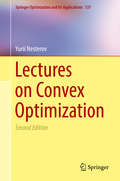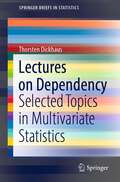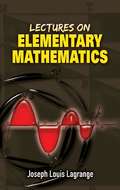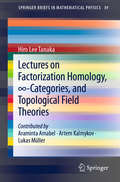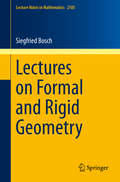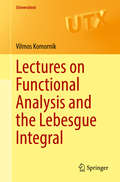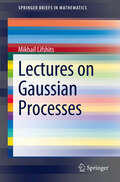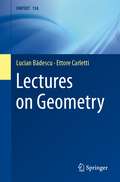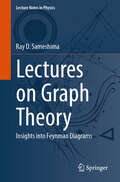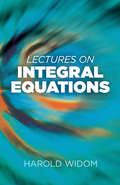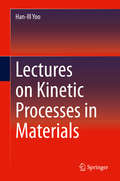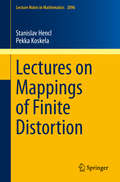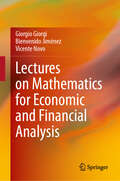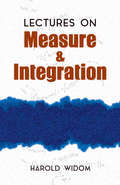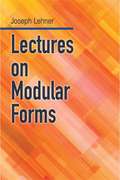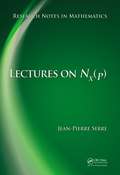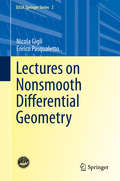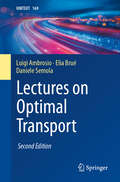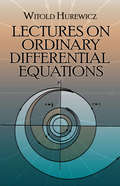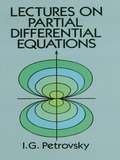- Table View
- List View
Lectures on Convex Optimization: A Basic Course (Springer Optimization and Its Applications #137)
by Yurii NesterovThis book provides a comprehensive, modern introduction to convex optimization, a field that is becoming increasingly important in applied mathematics, economics and finance, engineering, and computer science, notably in data science and machine learning. Written by a leading expert in the field, this book includes recent advances in the algorithmic theory of convex optimization, naturally complementing the existing literature. It contains a unified and rigorous presentation of the acceleration techniques for minimization schemes of first- and second-order. It provides readers with a full treatment of the smoothing technique, which has tremendously extended the abilities of gradient-type methods. Several powerful approaches in structural optimization, including optimization in relative scale and polynomial-time interior-point methods, are also discussed in detail. Researchers in theoretical optimization as well as professionals working on optimization problems will find this book very useful. It presents many successful examples of how to develop very fast specialized minimization algorithms. Based on the author’s lectures, it can naturally serve as the basis for introductory and advanced courses in convex optimization for students in engineering, economics, computer science and mathematics.
Lectures on Dependency: Selected Topics in Multivariate Statistics (SpringerBriefs in Statistics)
by Thorsten DickhausThis short book elaborates on selected aspects of stochastic-statistical dependencies in multivariate statistics. Each chapter provides a rigorous and self-contained treatment of one specific topic, poses a particular problem within its scope, and concludes by presenting its solution. The presented problems are not only relevant for research in mathematical statistics, but also entertaining, with elegant proofs and appealing solutions. The chapters cover correlation coefficients of bivariate normal distributions, empirical likelihood ratio tests for the population correlation, the rearrangement algorithm, covariances of order statistics, equi-correlation matrices, skew-normal distributions and the weighted bootstrap. This book is primarily intended for early-career researchers in mathematical statistics, but will also be interesting for lecturers in the field. Its goal is to rouse the reader’s interest, further their knowledge of the subject and provide them with some useful mathematical techniques.
Lectures on Elementary Mathematics (Dover Books on Mathematics)
by Joseph Louis LagrangeOne of the eighteenth century's greatest mathematicians, Lagrange made significant contributions to all fields of analysis and number theory. He survived the French Revolution to deliver these lectures in 1795 at the École Normale, a training school for teachers. An exemplar among elementary expositions, Lagrange's talks feature both originality of thought and elegance of expression.The five lectures begin with discussions of arithmetic that focus on fractions and logarithms as well as theory and applications. Subsequent talks consider algebra, with emphasis on the resolution of equations of the third and fourth degree, the resolution of numerical equations, and the employment of curves in the solution of problems. Students, teachers, and others with an interest in mathematics will find this volume a unique reading book in mathematics, with fascinating historical and philosophical remarks by a distinguished mathematician.
Lectures on Factorization Homology, ∞-Categories, and Topological Field Theories (SpringerBriefs in Mathematical Physics #39)
by Hiro Lee TanakaThis book provides an informal and geodesic introduction to factorization homology, focusing on providing intuition through simple examples. Along the way, the reader is also introduced to modern ideas in homotopy theory and category theory, particularly as it relates to the use of infinity-categories. As with the original lectures, the text is meant to be a leisurely read suitable for advanced graduate students and interested researchers in topology and adjacent fields.
Lectures on Formal and Rigid Geometry
by Siegfried BoschThe aim of this work is to offer a concise and self-contained 'lecture-style' introduction to the theory of classical rigid geometry established by John Tate, together with the formal algebraic geometry approach launched by Michel Raynaud. These Lectures are now viewed commonly as an ideal means of learning advanced rigid geometry, regardless of the reader's level of background. Despite its parsimonious style, the presentation illustrates a number of key facts even more extensively than any other previous work. This Lecture Notes Volume is a revised and slightly expanded version of a preprint that appeared in 2005 at the University of Münster's Collaborative Research Center "Geometrical Structures in Mathematics".
Lectures on Functional Analysis and the Lebesgue Integral
by Vilmos KomornikThis textbook, based on three series of lectures held by the author at the University of Strasbourg, presents functional analysis in a non-traditional way by generalizing elementary theorems of plane geometry to spaces of arbitrary dimension. This approach leads naturally to the basic notions and theorems. Most results are illustrated by the small â,,"p spaces. The Lebesgue integral, meanwhile, is treated via the direct approach of Frigyes Riesz, whose constructive definition of measurable functions leads to optimal, clear-cut versions of the classical theorems of Fubini-Tonelli and Radon-Nikodým. Lectures on Functional Analysis and the Lebesgue Integral presents the most important topics for students, with short, elegant proofs. The exposition style follows the Hungarian mathematical tradition of Paul ErdÅ's and others. The order of the first two parts, functional analysis and the Lebesgue integral, may be reversed. In the third and final part they are combined to study various spaces of continuous and integrable functions. Several beautiful, but almost forgotten, classical theorems are also included. Both undergraduate and graduate students in pure and applied mathematics, physics and engineering will find this textbook useful. Only basic topological notions and results are used and various simple but pertinent examples and exercises illustrate the usefulness and optimality of most theorems. Many of these examples are new or difficult to localize in the literature, and the original sources of most notions and results are indicated to help the reader understand the genesis and development of the field.
Lectures on Gaussian Processes
by Mikhail LifshitsGaussian processes can be viewed as a far-reaching infinite-dimensional extension of classical normal random variables. Their theory presents a powerful range of tools for probabilistic modelling in various academic and technical domains such as Statistics, Forecasting, Finance, Information Transmission, Machine Learning - to mention just a few. The objective of these Briefs is to present a quick and condensed treatment of the core theory that a reader must understand in order to make his own independent contributions. The primary intended readership are PhD/Masters students and researchers working in pure or applied mathematics. The first chapters introduce essentials of the classical theory of Gaussian processes and measures with the core notions of reproducing kernel, integral representation, isoperimetric property, large deviation principle. The brevity being a priority for teaching and learning purposes, certain technical details and proofs are omitted. The later chapters touch important recent issues not sufficiently reflected in the literature, such as small deviations, expansions, and quantization of processes. In university teaching, one can build a one-semester advanced course upon these Briefs.
Lectures on Geometry (UNITEXT #158)
by Lucian Bădescu Ettore CarlettiThis is an introductory textbook on geometry (affine, Euclidean and projective) suitable for any undergraduate or first-year graduate course in mathematics and physics. In particular, several parts of the first ten chapters can be used in a course of linear algebra, affine and Euclidean geometry by students of some branches of engineering and computer science. Chapter 11 may be useful as an elementary introduction to algebraic geometry for advanced undergraduate and graduate students of mathematics. Chapters 12 and 13 may be a part of a course on non-Euclidean geometry for mathematics students. Chapter 13 may be of some interest for students of theoretical physics (Galilean and Einstein’s general relativity). It provides full proofs and includes many examples and exercises. The covered topics include vector spaces and quadratic forms, affine and projective spaces over an arbitrary field; Euclidean spaces; some synthetic affine, Euclidean and projective geometry; affine and projective hyperquadrics with coefficients in an arbitrary field of characteristic different from 2; Bézout’s theorem for curves of P^2 (K), where K is a fixed algebraically closed field of arbitrary characteristic; and Cayley-Klein geometries.
Lectures on Graph Theory: Insights into Feynman Diagrams (Lecture Notes in Physics #1035)
by Ray D. SameshimaThis book introduces foundational topics such as group theory, fields, linear algebra, matrix theory, and graph theory, providing readers with the essential background needed to understand Feynman diagrams and their integral representations. The book highlights Feynman's parametrization as a central tool for studying Feynman integrals, starting with the traditional momentum representation. Schwinger and Lee-Pomeransky parametrizations are covered in a supplementary chapter. Readers will develop a clear understanding of the mathematical properties and practical applications of these techniques, with a particular emphasis on Feynman’s approach. Advanced topics such as integration-by-parts identities and intersection number theory are explored in the final chapter, offering readers a gateway to key mathematical structures. The prerequisites are minimal—only a basic familiarity with algebra and calculus is recommended. The content begins with introductory concepts and gradually progresses to more advanced material, ensuring a balanced learning curve. Practical examples throughout the book reinforce the main ideas, allowing readers to apply what they’ve learned and deepen their understanding as they move through the material.
Lectures on Infinitary Model Theory
by David MarkerInfinitary logic, the logic of languages with infinitely long conjunctions, plays an important role in model theory, recursion theory and descriptive set theory. This book is the first modern introduction to the subject in forty years, and will bring students and researchers in all areas of mathematical logic up to the threshold of modern research. The classical topics of back-and-forth systems, model existence techniques, indiscernibles and end extensions are covered before more modern topics are surveyed. Zilber's categoricity theorem for quasiminimal excellent classes is proved and an application is given to covers of multiplicative groups. Infinitary methods are also used to study uncountable models of counterexamples to Vaught's conjecture, and effective aspects of infinitary model theory are reviewed, including an introduction to Montalbán's recent work on spectra of Vaught counterexamples. Self-contained introductions to effective descriptive set theory and hyperarithmetic theory are provided, as is an appendix on admissible model theory.
Lectures on Integral Equations (Dover Books on Mathematics)
by Harold WidomThis concise and classic volume presents the main results of integral equation theory as consequences of the theory of operators on Banach and Hilbert spaces. In addition, it offers a brief account of Fredholm's original approach. The self-contained treatment requires only some familiarity with elementary real variable theory, including the elements of Lebesgue integration, and is suitable for advanced undergraduates and graduate students of mathematics.Other material discusses applications to second order linear differential equations, and a final chapter uses Fourier integral techniques to investigate certain singular integral equations of interest for physical applications as well as for their own sake. A helpful index concludes the text.
Lectures on K3 Surfaces
by Daniel HuybrechtsK3 surfaces are central objects in modern algebraic geometry. This book examines this important class of Calabi-Yau manifolds from various perspectives in eighteen self-contained chapters. It starts with the basics and guides the reader to recent breakthroughs, such as the proof of the Tate conjecture for K3 surfaces and structural results on Chow groups. Powerful general techniques are introduced to study the many facets of K3 surfaces, including arithmetic, homological, and differential geometric aspects. In this context, the book covers Hodge structures, moduli spaces, periods, derived categories, birational techniques, Chow rings, and deformation theory. Famous open conjectures, for example the conjectures of Calabi, Weil, and Artin-Tate, are discussed in general and for K3 surfaces in particular, and each chapter ends with questions and open problems. Based on lectures at the advanced graduate level, this book is suitable for courses and as a reference for researchers.
Lectures on Kinetic Processes in Materials
by Han-Ill YooThis book provides beginning graduate or senior-level undergraduate students in materials disciplines with a primer of the fundamental and quantitative ideas on kinetic processes in solid materials. Kinetics is concerned with the rate of change of the state of existence of a material system under thermodynamic driving forces. Kinetic processes in materials typically involve chemical reactions and solid state diffusion in parallel or in tandem. Thus, mathematics of diffusion in continuum is first dealt with in some depth, followed by the atomic theory of diffusion and a brief review of chemical reaction kinetics. Chemical diffusion in metals and ionic solids, diffusion-controlled kinetics of phase transformations, and kinetics of gas-solid reactions are examined. Through this course of learning, a student will become able to predict quantitatively how fast a kinetic process takes place, to understand the inner workings of the process, and to design the optimal process of material state change.Provides students with the tools to predict quantitatively how fast a kinetic process takes place and solve other diffusion related problems;Learns fundamental and quantitative ideas on kinetic processes in solid materials;Examines chemical diffusion in metals and ionic solids, diffusion-controlled kinetics of phase transformations, and kinetics of gas-solid reactions, among others;Contains end-of chapter exercise problems to help reinforce students' grasp of the concepts presented within each chapter.
Lectures on Logarithmic Algebraic Geometry (Cambridge Studies in Advanced Mathematics #178)
by Arthur OgusThis graduate textbook offers a self-contained introduction to the concepts and techniques of logarithmic geometry, a key tool for analyzing compactification and degeneration in algebraic geometry and number theory. It features a systematic exposition of the foundations of the field, from the basic results on convex geometry and commutative monoids to the theory of logarithmic schemes and their de Rham and Betti cohomology. The book will be of use to graduate students and researchers working in algebraic, analytic, and arithmetic geometry as well as related fields.
Lectures on Lyapunov exponents
by Marcelo VianaThe theory of Lyapunov exponents originated over a century ago in the study of the stability of solutions of differential equations. Written by one of the subject's leading authorities, this book is both an account of the classical theory, from a modern view, and an introduction to the significant developments relating the subject to dynamical systems, ergodic theory, mathematical physics and probability. It is based on the author's own graduate course and is reasonably self-contained with an extensive set of exercises provided at the end of each chapter. This book makes a welcome addition to the literature, serving as a graduate text and a valuable reference for researchers in the field.
Lectures on Mappings of Finite Distortion
by Pekka Koskela Stanislav HenclIn this book we introduce the class of mappings of finite distortion as a generalization of the class of mappings of bounded distortion. Connections with models of nonlinear elasticity are also discussed. We study continuity properties, behavior of our mappings on null sets, topological properties like openness and discreteness, regularity of the potential inverse mappings and many other aspects.
Lectures on Mathematics for Economic and Financial Analysis
by Giorgio Giorgi Bienvenido Jiménez Vicente NovoThis book offers a comprehensive yet approachable introduction to essential mathematical concepts, tailored specifically for undergraduate and first-year graduate students in Economics and Social Sciences. Based on lectures delivered at the University of Pavia's Department of Economics and Management, and also in UNED’ Department of Applied Mathematics in Madrid, it aims to equip students with the mathematical tools necessary to better understand their courses in economics and finance, where math is applied directly. Unlike texts focused on formalized topics like Mathematical Economics or Operations Research, this book presents basic mathematical principles and methods that are immediately relevant to students. With a clear, accessible approach, it includes numerous examples, some with economic applications, to illustrate key concepts and make them easier to grasp. The authors have carefully chosen proofs that are straightforward and beneficial for students to encounter, offering an introduction to important proof techniques without overwhelming complexity. The book also provides a select bibliography, allowing readers to explore topics in greater depth if desired. Drawing on years of teaching experience, the authors have created a valuable resource that serves as both a foundation and a practical guide for students navigating the mathematical aspects of economics and social science courses.
Lectures on Measure and Integration (Dover Books on Mathematics)
by Harold WidomThese well-known and concise lecture notes present the fundamentals of the Lebesgue theory of integration and an introduction to some of the theory's applications. Suitable for advanced undergraduates and graduate students of mathematics, the treatment also covers topics of interest to practicing analysts. Author Harold Widom emphasizes the construction and properties of measures in general and Lebesgue measure in particular as well as the definition of the integral and its main properties. The notes contain chapters on the Lebesgue spaces and their duals, differentiation of measures in Euclidean space, and the application of integration theory to Fourier series.
Lectures on Modular Forms
by Joseph J. LehnerThis concise volume presents an expository account of the theory of modular forms and its application to number theory and analysis. Suitable for advanced undergraduates and graduate students in mathematics, the treatment starts with classical material and leads gradually to modern developments. Prerequisites include a grasp of the elements of complex variable theory, group theory, and number theory. The opening chapters define modular forms, develop their most important properties, and introduce the Hecke modular forms. Subsequent chapters explore the automorphisms of a compact Riemann surface, develop congruences and other arithmetic properties for the Fourier coefficients of Klein's absolute modular invariant, and discuss analogies with the Hecke theory as well as with the Ramanujan congruences for the partition function. Substantial notes at the end of each chapter provide detailed explanations of the text's more difficult points.
Lectures on N_X (Research Notes in Mathematics)
by Jean-Pierre SerreLectures on NX(p) deals with the question on how NX(p), the number of solutions of mod p congruences, varies with p when the family (X) of polynomial equations is fixed. While such a general question cannot have a complete answer, it offers a good occasion for reviewing various techniques in l-adic cohomology and group representations, presented in
Lectures on Nonsmooth Differential Geometry (SISSA Springer Series #2)
by Nicola Gigli Enrico PasqualettoThis book provides an introduction to some aspects of the flourishing field of nonsmooth geometric analysis. In particular, a quite detailed account of the first-order structure of general metric measure spaces is presented, and the reader is introduced to the second-order calculus on spaces – known as RCD spaces – satisfying a synthetic lower Ricci curvature bound. Examples of the main topics covered include notions of Sobolev space on abstract metric measure spaces; normed modules, which constitute a convenient technical tool for the introduction of a robust differential structure in the nonsmooth setting; first-order differential operators and the corresponding functional spaces; the theory of heat flow and its regularizing properties, within the general framework of “infinitesimally Hilbertian” metric measure spaces; the RCD condition and its effects on the behavior of heat flow; and second-order calculus on RCD spaces. The book is mainly intended for young researchers seeking a comprehensive and fairly self-contained introduction to this active research field. The only prerequisites are a basic knowledge of functional analysis, measure theory, and Riemannian geometry.
Lectures on Optimal Transport (UNITEXT #130)
by Luigi Ambrosio Elia Brué Daniele SemolaThis textbook is addressed to PhD or senior undergraduate students in mathematics, with interests in analysis, calculus of variations, probability and optimal transport. It originated from the teaching experience of the first author in the Scuola Normale Superiore, where a course on optimal transport and its applications has been given many times during the last 20 years. The topics and the tools were chosen at a sufficiently general and advanced level so that the student or scholar interested in a more specific theme would gain from the book the necessary background to explore it. After a large and detailed introduction to classical theory, more specific attention is devoted to applications to geometric and functional inequalities and to partial differential equations.
Lectures on Optimal Transport (UNITEXT #169)
by Luigi Ambrosio Elia Brué Daniele SemolaThis textbook is addressed to PhD or senior undergraduate students in mathematics, with interests in analysis, calculus of variations, probability and optimal transport. It originated from the teaching experience of the first author in the Scuola Normale Superiore, where a course on optimal transport and its applications has been given many times during the last 20 years. The topics and the tools were chosen at a sufficiently general and advanced level so that the student or scholar interested in a more specific theme would gain from the book the necessary background to explore it. After a large and detailed introduction to classical theory, more specific attention is devoted to applications to geometric and functional inequalities and to partial differential equations. This is the second edition of the book, first published in 2018. It includes refinement of proofs, an updated bibliography and a more detailed discussion of minmax principles, with the aim of giving two fully self-contained proofs of Kantorovich duality.
Lectures on Ordinary Differential Equations (Dover Books on Mathematics)
by Witold HurewiczHailed by The American Mathematical Monthly as "a rigorous and lively introduction," this text explores a topic of perennial interest in mathematics. The author, a distinguished mathematician and formulator of the Hurewicz theorem, presents a clear and lucid treatment that emphasizes geometric methods. Topics include first-order scalar and vector equations, basic properties of linear vector equations, and two-dimensional nonlinear autonomous systems. Suitable for senior mathematics students, the text begins with an examination of differential equations of the first order in one unknown function. Subsequent chapters address systems of differential equations, linear systems of differential equations, singularities of an autonomous system, and solutions of an autonomous system in the large.
Lectures on Partial Differential Equations
by I. G. PetrovskyThe field of partial differential equations is an extremely important component of modern mathematics. It has great intrinsic beauty and virtually unlimited applications. This book, written for graduate-level students, grew out of a series of lectures the late Professor Petrovsky gave at Moscow State University. The first chapter uses physical problems to introduce the subjects and explains its division into hyperbolic, elliptic, and parabolic partial differential equations. Each of these three classes of equations is dealt with in one of the remaining three chapters of the book in a manner that is at once rigorous, transparent, and highly readable.Petrovsky was a leading figure in Russian mathematics responsible for many advances in the field of partial differential equations. In these masterly lectures, his commentary and discussion of various aspects of the problems under consideration will prove valuable in deepening students’ understanding and appreciation of these problems.
